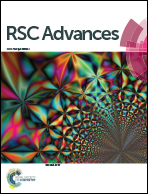Insights into the interactions between porcine collagen and a Zr–Al–Ti metal complex
Abstract
Porcine acelluar dermal matrix (pADM), known as pure collagen with three dimensional structure, was used to explore the interactions between porcine collagen and a metal complex in this study. The metal complex mainly consists of elements Zr, Al and Ti (patented product named DMT-II). Tests of Fourier transform infrared spectrometry (FTIR), the crosslinking degree, Diffraction Scanning Calorimetry (DSC), Scanning Electron Microscopy (SEM) and X-ray diffraction (XRD) were carried out to further probe the microscopic changes between collagen and the metal complex. Results have revealed that the DMT-II could react with collagen between fibers and at functional groups in the collagen molecules. The unique structure of collagen has been retained with only small changes of intensity of the characteristic absorption peaks appeared. The highest thermal denaturation temperature of pADM after reaction with DMT-II (50%) was 86.6 °C, which has been improved by 18.9 °C. The crystal structure analyzed by XRD showed that DMT-II affected the triple helical structure of collagen to some degree, proving that the reaction took place at the collagen molecules. Through morphology observation, it was clear that DMT-II changed the fiber distribution, and the fibers in pADM assembled together to form a tight layer. By a series of tests, results showed that the reaction between collagen and DMT-II could take place both in fibers and in collagen molecules, which paved a new way for collagen modification.


 Please wait while we load your content...
Please wait while we load your content...